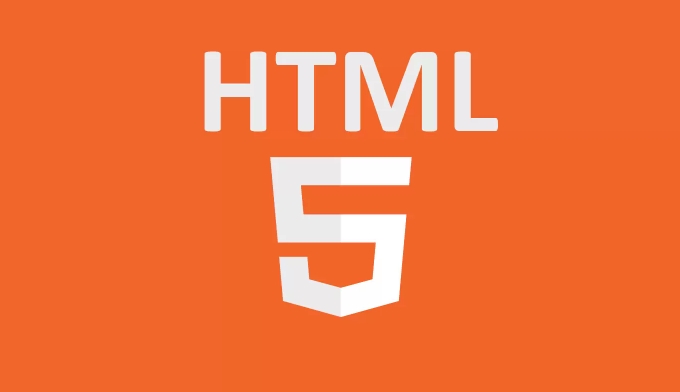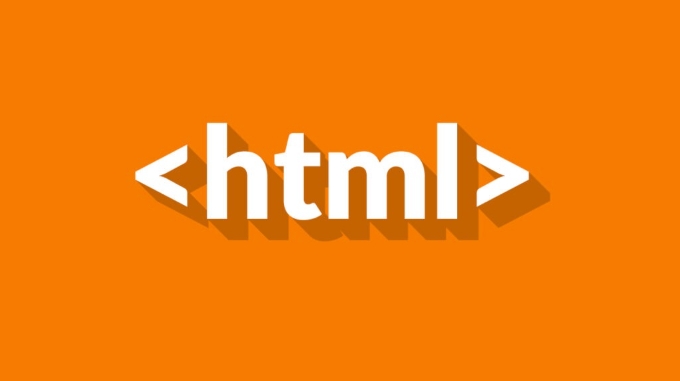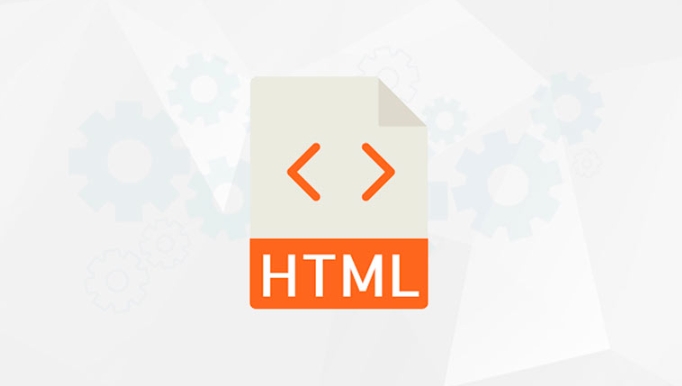To create a scrollbar of HTML element, you need to control overflow behavior through CSS: 1. Set a fixed height for the element and use the overflow attribute, such as overflow: auto displays the scrollbar when needed, and overflow: scroll always displays; 2. You can control vertical or horizontal scrolling alone, such as overflow-y: auto scrolls only vertically; 3. You can customize the scrollbar style through pseudo-elements such as::-webkit-scrollbar. You can use scrollbar-width and scrollbar-color to achieve basic beautification in Firefox. Finally, you can limit the container size and allow content to overflow to achieve scrolling effect.

To create a scrollbar in an HTML element, you use CSS to control the overflow behavior of the element. The scrollbar appears automatically when the content inside the element is too large to fit in its defined area.

Here's how to do it:
1. Set a Fixed Size and Enable Overflow
You need to:

- Define a fixed height (or max-height) for the element.
- Use the
overflowproperty to tell the browser how to handle content that overflows.
<div class="scrollable-box"> <p>Long content goes here...</p> <p>More content...</p> <!-- This content should be enough to overflow --> </div>
.scrollable-box {
width: 300px;
height: 200px;
overflow: auto; /* or 'scroll' */
border: 1px solid #ccc;
}2. Choose the Right Overflow Value
-
overflow: auto– Shows a scrollbar only when necessary (recommended for most cases). -
overflow: scroll– Always shows scrollbars (even if not needed), both horizontally and vertically. -
overflow-y: auto– Enables vertical scrollbar only when needed. -
overflow-x: auto– Enables horizontal scrollbar only when needed.
Example for vertical scrolling only:
.scrollable-box {
width: 300px;
height: 200px;
overflow-y: auto;
overflow-x: hidden;
border: 1px solid #ddd;
}3. Customize Scrollbar Appearance (Optional)
You can style the scrollbar using CSS, especially in WebKit browsers (Chrome, Edge, Safari):

/* For WebKit browsers */
.scrollable-box::-webkit-scrollbar {
width: 8px;
}
.scrollable-box::-webkit-scrollbar-thumb {
background-color: #888;
border-radius: 4px;
}
.scrollable-box::-webkit-scrollbar-thumb:hover {
background-color: #555;
} Note: Firefox and other browsers have limited support for scrollbar customization, but you can use scrollbar-width and scrollbar-color for basic styling.
/* For Firefox */
.scrollable-box {
scrollbar-width: thin;
scrollbar-color: #888 #f1f1f1;
}Key Points:
- The container must have a constrained height (or width) for scrollbars to appear.
- Content must exceed the container's dimensions.
- Use
overflow: autofor a clean, conditional scrollbar. - You can style scrollbars, but cross-browser consistency varies.
Basically, it's not about adding a scrollbar directly—it's about controlling overflow in a sized container. That's how you get a working, and optionally styled, scrollbar.
The above is the detailed content of How do you create a scrollbar in an HTML element?. For more information, please follow other related articles on the PHP Chinese website!

Hot AI Tools

Undress AI Tool
Undress images for free

Undresser.AI Undress
AI-powered app for creating realistic nude photos

AI Clothes Remover
Online AI tool for removing clothes from photos.

Clothoff.io
AI clothes remover

Video Face Swap
Swap faces in any video effortlessly with our completely free AI face swap tool!

Hot Article

Hot Tools

Notepad++7.3.1
Easy-to-use and free code editor

SublimeText3 Chinese version
Chinese version, very easy to use

Zend Studio 13.0.1
Powerful PHP integrated development environment

Dreamweaver CS6
Visual web development tools

SublimeText3 Mac version
God-level code editing software (SublimeText3)

Hot Topics
 How does React handle focus management and accessibility?
Jul 08, 2025 am 02:34 AM
How does React handle focus management and accessibility?
Jul 08, 2025 am 02:34 AM
React itself does not directly manage focus or accessibility, but provides tools to effectively deal with these issues. 1. Use Refs to programmatically manage focus, such as setting element focus through useRef; 2. Use ARIA attributes to improve accessibility, such as defining the structure and state of tab components; 3. Pay attention to keyboard navigation to ensure that the focus logic in components such as modal boxes is clear; 4. Try to use native HTML elements to reduce the workload and error risk of custom implementation; 5. React assists accessibility by controlling the DOM and adding ARIA attributes, but the correct use still depends on developers.
 Describe the difference between shallow and full rendering in React testing.
Jul 06, 2025 am 02:32 AM
Describe the difference between shallow and full rendering in React testing.
Jul 06, 2025 am 02:32 AM
Shallowrenderingtestsacomponentinisolation,withoutchildren,whilefullrenderingincludesallchildcomponents.Shallowrenderingisgoodfortestingacomponent’sownlogicandmarkup,offeringfasterexecutionandisolationfromchildbehavior,butlacksfulllifecycleandDOMinte
 What is the significance of the StrictMode component in React?
Jul 06, 2025 am 02:33 AM
What is the significance of the StrictMode component in React?
Jul 06, 2025 am 02:33 AM
StrictMode does not render any visual content in React, but it is very useful during development. Its main function is to help developers identify potential problems, especially those that may cause bugs or unexpected behavior in complex applications. Specifically, it flags unsafe lifecycle methods, recognizes side effects in render functions, and warns about the use of old string refAPI. In addition, it can expose these side effects by intentionally repeating calls to certain functions, thereby prompting developers to move related operations to appropriate locations, such as the useEffect hook. At the same time, it encourages the use of newer ref methods such as useRef or callback ref instead of string ref. To use Stri effectively
 Vue with TypeScript Integration Guide
Jul 05, 2025 am 02:29 AM
Vue with TypeScript Integration Guide
Jul 05, 2025 am 02:29 AM
Create TypeScript-enabled projects using VueCLI or Vite, which can be quickly initialized through interactive selection features or using templates. Use tags in components to implement type inference with defineComponent, and it is recommended to explicitly declare props and emits types, and use interface or type to define complex structures. It is recommended to explicitly label types when using ref and reactive in setup functions to improve code maintainability and collaboration efficiency.
 How to handle forms in Vue
Jul 04, 2025 am 03:10 AM
How to handle forms in Vue
Jul 04, 2025 am 03:10 AM
There are three key points to be mastered when processing Vue forms: 1. Use v-model to achieve two-way binding and synchronize form data; 2. Implement verification logic to ensure input compliance; 3. Control the submission behavior and process requests and status feedback. In Vue, form elements such as input boxes, check boxes, etc. can be bound to data attributes through v-model, such as automatically synchronizing user input; for multiple selection scenarios of check boxes, the binding field should be initialized into an array to correctly store multiple selected values. Form verification can be implemented through custom functions or third-party libraries. Common practices include checking whether the field is empty, using a regular verification format, and displaying prompt information when errors are wrong; for example, writing a validateForm method to return the error message object of each field. You should use it when submitting
 Server-Side Rendering with Next.js Explained
Jul 23, 2025 am 01:39 AM
Server-Side Rendering with Next.js Explained
Jul 23, 2025 am 01:39 AM
Server-siderendering(SSR)inNext.jsgeneratesHTMLontheserverforeachrequest,improvingperformanceandSEO.1.SSRisidealfordynamiccontentthatchangesfrequently,suchasuserdashboards.2.ItusesgetServerSidePropstofetchdataperrequestandpassittothecomponent.3.UseSS
 A Deep Dive into WebAssembly (WASM) for Front-End Developers
Jul 27, 2025 am 12:32 AM
A Deep Dive into WebAssembly (WASM) for Front-End Developers
Jul 27, 2025 am 12:32 AM
WebAssembly(WASM)isagame-changerforfront-enddevelopersseekinghigh-performancewebapplications.1.WASMisabinaryinstructionformatthatrunsatnear-nativespeed,enablinglanguageslikeRust,C ,andGotoexecuteinthebrowser.2.ItcomplementsJavaScriptratherthanreplac
 What is content security policy CSP
Jul 04, 2025 am 03:21 AM
What is content security policy CSP
Jul 04, 2025 am 03:21 AM
Content Security Policy (CSP) prevents attacks such as XSS by limiting the loading source of web page resources. Its core mechanism is to set a whitelist to prevent unauthorized scripts from being executed. The steps to enable include: 1. Define the policy and clarify the allowed resource sources; 2. Add Content-Security-PolicyHTTP header to the server; 3. Use Report-Only mode to test and debug in the initial stage; 4. Continuous monitoring and optimization strategies to ensure that they do not affect normal functions. Notes include handling inline scripts, careful use of third-party resources, compatibility support, and other irreplaceable security measures.






